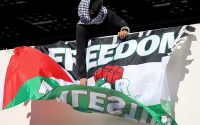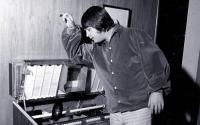11 June 2009
by Robert Dreyfusswww.thenation.com/blogs/dreyfuss/442907/iran_s_election_tension
It's a quiet Thursday in Tehran. Campaigning and electioneering is forbidden on election eve, and the crowds are gone, but the tension is palpable. Here and there are still visible people wearing the ubiquitous green armbands that signal support for former Prime Minister Mousavi. Everyone, but everyone, has only one thing on their minds, and rumors are flying, gossip is exchanged, and the latest news--true or not--is passed from mouth to mouth and via cell phone and text messages. Outside the gigantic, concrete edifice of the Interior Ministry, which has responsibility for counting the votes, a pair of young women wearing green smiled as we passed each other. It's inside that building, overlooked by a huge portrait of Ayatollah Khomeini, where many Iranians worry that the vote will be stolen.
Though quiet now, over the past several days Iran has seen an outburst of political activity that far surpasses anythinge the gathering storm of the 1978-79 toppling of the Pahlavi dynasty. Last evening, I strolled across the campus of Tehran University, Iran's largest and most prestigious school. In the streets outside, thousands of green-clad students were laughing, cheering and carrying banners, and from the rooftops across the street people were throwing confetti that rained down on the streets below. Cars and vans, flying green flags, cruised the streets. A small group of supporters of President Ahmadinejad marched past, drawing jeers and mocking chants. A guard at the gate, an older man who lost a leg in the 1980s war with Iraq, smiled approvingly and said, of the Mousavi crowd, "It's a revolution."
A revolution. That's a phrase I've heard over and over again in the last few days, from students, office workers, taxi drivers, and passersby.
In fact, it may be something less than that, since all three challengers to Ahmadinejad, including Mousavi, are establishment figures. Yet there's no denying the political and social movement that is building against the president, mostly around Mousavi's brilliant campaign. And the contempt for Ahmadinejad is everywhere, from well-connected observers and analysts, government officials, and ordinary Iranians I've encountered. A few days ago, as I headed over to Ahmadinejad's campaign headquarters, I stopped a man to ask directions. "Ahmadinejad! Why do you want to go see him? He destroyed the country!" A few blocks later, a well-dressed man comes up to me, just outside the president's government office and down an alley from the campaign headquarters. He introduces himself as an employee in the office of the president. He says that Ahmadinejad is a fool. And he adds: "The mullahs [the Iranian clergy] are like idols. They must be broken!" He pulls down his shirt to show me a bullet wound from the war.
To counter the Mousavi green, the Ahmadinejad campaign has wrapped itself in the Iranian flag--literally. Like proper ultranationalist extremists, or perhaps like Republicans, the president's campaign is using Iran's tricolor flag as its election symbol. At an Ahmadinejad rally, thousands of Iranian flags are handed out by campaign workers, and the crowd shakes the flags as if they were spears in combat. But at a competing Mousavi rally, 20,000 supporters chant: "Mousavi! Mousavi! Take back my flag!"
There's worry and anger about cheating and unfair campaigning. Yesterday, the state-run Iranian TV gave Ahmadinejad twenty minutes of free air time for a speech, while offering one minute each to his three rivals. (They turned it down contemptuously.) At a Mousavi rally, people chant: "Iranian TV has become Ahmadinejad's PlayStation!" A man says that if there is evidence of cheating, people won't stand for it. Later, the crowd chants: "If there is any cheating, we are going to make hell in Iran!" Rumors that people would storm the offices of Iranian TV if Ahmadinejad were given the free time proved unfounded, and the speech was aired without incident.
But there's an uneasy feeling that, especially if the vote is close, one side or the other won't accept the results. Perhaps the greatest danger comes from the angry, inflamed supporters of Ahmadinejad, though a highly informed analyst says that Iran's Leader, Ali Khamenei, will be able to control the backers of Ahmadinejad in the event of a Mousavi victory. But there's no question that Iran is highly divided, and when the results are announced--probably Saturday morning--there will be a few days of tension before it's clear how the voters on the losing side react.
"I hope the gap is wide enough that the losing side accepts it," says a well-known professor at Tehran University. If Ahmadinejad loses, if the gap is wide, Khamenei will put a lot of pressure on him not to make trouble."
The reality is that Khamenei and his all-powerful Council of Guardians has approved all four candidates, and virtually everyone I've spoken with says that the Leader will be happy if either Ahmadinejad or Mousavi wins. It's even likely that Khamenei may have decided that Ahmadinejad has served his purpose, and that a more acceptable, more moderate president would better serve Iran's broader interests. "When Bush was president, perhaps Iran needed a barking dog to response to the barking dog in Washington," says one Iranian observer. "But now, with Obama, it's different."
Perhaps. The neoconservatives argue that, whoever wins, the ruling powers-that-be will remain--and that's true, as far as it goes. But there's no denying that two vastly different, competing social movements have been mobilized for this election, and that very real social forces are at work.






